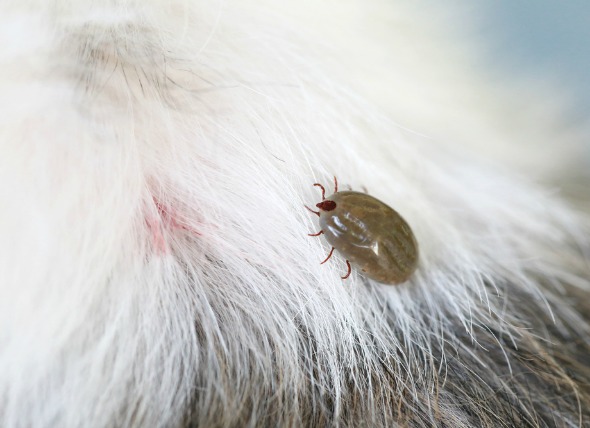

Bartonellosis is an emerging infectious bacterial disease in dogs, caused by the gram-negative bacteria Bartonella, which may affect cats and humans as well. In humans, infection of the Bartonella bacterium is also known as cat scratch disease (CSD), though it may not have necessarily been acquired through a cat's scratch or bite.
The Bartonella spp bacterium is transmitted to dogs via fleas, sand flies, lice, and ticks. Herding and hunting dogs are at higher risk due to increased exposure to vectors like sand flies, lice, fleas, and ticks. Another important aspect of this disease is that both dogs and humans share a common spectrum of clinical symptoms.
This is a zoonotic disease, meaning that it can be transmitted between animals and humans. Fortunately, this disease is not fatal for humans, but it still poses great risks to immunocompromised patients, such as those with the AIDS virus, or those undergoing chemical treatment.
The majority of human patients are less than 21 years of age. The following symptoms are commonly seen in humans:
Symptoms in dogs include:
There is usually a history of dog bite in affected humans. Symptoms of infection of the Bartonella bacterium include a characteristic papule at the site of the bite wound.
If your dog is suspected of being infected with Bartonella spp., your veterinarian will conduct a complete examination, which will include laboratory ordered blood tests, a biochemistry profile, and a urinalysis.
Various abnormalities may be present, such as a decreased number of platelets (the cells required for blood clotting), or anemia. An increased number of white blood cells (WBCs), or leukocytosis may also be evident in blood testing. Biochemistry profiling may reveal abnormal liver enzymes and a decreased concentration of albumin (a protein in blood) in affected dogs. Confirmation of the presence of Bartonella spp. will also involve a positive result from growing, or culturing the organisms from a sample of infected blood. A polymerase chain reaction (PCR) test is a more advanced method for detecting bacterial DNA using a sample of tissue taken from lesion.
In humans the bite or scratched site is cleansed and thoroughly disinfected. In cases with swollen or painful lymph nodes, the lymph nodes can be aspirated to remove excess pus. Generally, this is a minor illness, similar to a common flu. Bed rest is suggested until the symptoms have subsided for preventing further aggravation of symptoms, and in severe cases antimicrobial therapy may be advised. Most cases resolve within a few weeks, and in some cases, minor symptoms, such as swollen glands and fatigue, may linger for a few months.
A well-established antibiotic protocol does not exist for the treatment of bartonellosis in dogs. Depending on the symptoms, a selection of antibiotics will be made by your veterinarian on an individual basis.
Immunocompromised patients (e.g. people with AIDS and people who are undergoing chemotherapy) are at a higher risk for developing more severe symptoms and should avoid being bitten by a dog. This includes rough play with dogs, and playing with puppies, which are prone to nipping.
The exact risk of transmission of this disease from dogs to humans is unknown; however, if you have been bitten by a dog, contact your physician for proper advice. The overall prognosis of this disease in dogs is highly variable and dependent on the clinical presentation of this disease. After the initial treatment, you should monitor your dog for any recurrence of clinical signs, calling your veterinarian if you see any untoward symptoms in your dog. Please note that as this disease has not yet been fully described and understood in dogs, full resolution of the disease after treatment may not be achieved.
The best prevention is to protect your dog as best as you can from exposure to fleas, ticks, sand flies, and lice.
 Botulism in Dogs
Clostridium botulinum in Dogs
Botulism is a rare
Botulism in Dogs
Clostridium botulinum in Dogs
Botulism is a rare
 Skin Blisters and Pustules in Dogs
Bullous Pemphigoid in Dogs
Bullous pemphigoid is
Skin Blisters and Pustules in Dogs
Bullous Pemphigoid in Dogs
Bullous pemphigoid is
 Plague in Dogs
Yersinia pestis in Dogs
Plague is a bacterial dis
Plague in Dogs
Yersinia pestis in Dogs
Plague is a bacterial dis
 Aspirin Poisoning in Dogs
Aspirin Toxicity in Dogs
Aspirin, a non-steroidal
Aspirin Poisoning in Dogs
Aspirin Toxicity in Dogs
Aspirin, a non-steroidal
 Inflammation of the Middle Ear and External Ear Canal in Dogs
Otitis externa and Otitis media in Dogs
Otitis ex
Inflammation of the Middle Ear and External Ear Canal in Dogs
Otitis externa and Otitis media in Dogs
Otitis ex
Copyright © 2005-2016 Pet Information All Rights Reserved
Contact us: www162date@outlook.com